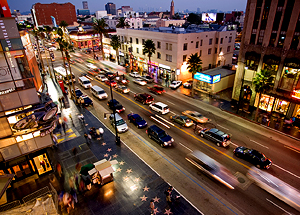
Wicked Lit is back for 2015 at Altadena’s Mountain View Mausoleum And Cemetery, a venue so mysterious and spooky that it’s helped make this creepy, kooky trio of terrorific one-acts an annual L.A. tradition for the past half-dozen years and counting.
Like Tamara, The Manor, The House Of Besarab, and other Wicked Lits before it, Wicked Lit 2015 has its audience traveling from room to room—or in this case from crypt to chapel to columbarium to graveyard—as its actors bring to life (or should that be death?) its tales of terror and suspense.
The order in which you see The Ebony Frame, The Grove of Rashomon, and The Fall of the House of Usher will depend on which of the three color-coded groups of 25 or so you’re assigned to, but each Wicked Lit experience begins (and groups reunite) in the entry courtyard, where the wacky The System (conceived, written, and directed by Debbie McMahon, based on the short story The System Of Dr. Tarr And Prof. Fether by Edgar Allan Poe) gets the assembling crowd in the mood for the evening ahead.
 The Ebony Frame (by Susannah Myrvold, directed by Jaime Robledo, adapted from the short story of the same name by Edith Nesbit) may remind you a bit of the film noir classic Laura (man falls for unknown woman in painting), though this time round it’s a Renaissance Spanish beauty inside the titular frame, a señorita whose return from the grave puts our hero Henry’s engagement in jeopardy until Satan shows up in all his horned glory to tie the nuptial knot. (Unlike The Grove Of Rashoman and The Fall of the House of Usher, which play it deadly serious, The Ebony Frame has a delightfully tongue-in-cheek tone.)
The Ebony Frame (by Susannah Myrvold, directed by Jaime Robledo, adapted from the short story of the same name by Edith Nesbit) may remind you a bit of the film noir classic Laura (man falls for unknown woman in painting), though this time round it’s a Renaissance Spanish beauty inside the titular frame, a señorita whose return from the grave puts our hero Henry’s engagement in jeopardy until Satan shows up in all his horned glory to tie the nuptial knot. (Unlike The Grove Of Rashoman and The Fall of the House of Usher, which play it deadly serious, The Ebony Frame has a delightfully tongue-in-cheek tone.)
The Grove Of Rashoman (by Jonathan Josephson, directed by Darin Anthony, adapted from In A Grove by Ryūnosuke Akutagawa) takes place in Mountain View’s gravestone-adorned outdoor cemetery, focusing on an ancient Japanese woman’s search for her lost daughter Masago following the death of Masago’s samurai lover, Takehiko. Like the Kurosawa movie classic Rashoman, Josephson’s one-act presents various versions about what might have happened … before ghosts appear to set the record straight.
The Fall of the House of Usher (by Paul Millet, directed by Jeff G. Rack, adapted from the short story of the same name by Edgar Allan Poe) focuses on Nathaniel, whose visit to his longtime friend Roderick Usher is highlighted (lowlighted?) by the burial of Roderick’s mysteriously ill sister Madeline, who may or may not be dead. (That this one-act takes place inside the cathedral-like mausoleum itself only adds to its impact.)
Not only are this year’s playlets entirely different from last year’s, the latter two either take place in previously unvisited sections of Mountain View or are seen from different perspectives, making a return visit no retread of previous Wicked Lits.
 Under a topnotch team of directors, Alan Abelew, Deborah Dominguez, Kevin Dulude, Joe Fria, Angie Hobin, Kyle Fox, Sachiyo K, Carlos Larkin, Lance Lott, Hisato Masuyama, Devon Michaels, Laura Napoli, Mark Ostrander, Robert Paterno, Michael Prichard, AJ Shiryo, Alpha Takahashi, Tina Van Berckelaer, and Kazumi Zatkin (at the performance reviewed) do all around splendid work, with added points for those among them who repeat the same one-act three times a night with equal energy and commitment. (I especially loved Dulude’s deliciously quirky, gender-bending Nurse Racher and his maleficent Satan.)
Under a topnotch team of directors, Alan Abelew, Deborah Dominguez, Kevin Dulude, Joe Fria, Angie Hobin, Kyle Fox, Sachiyo K, Carlos Larkin, Lance Lott, Hisato Masuyama, Devon Michaels, Laura Napoli, Mark Ostrander, Robert Paterno, Michael Prichard, AJ Shiryo, Alpha Takahashi, Tina Van Berckelaer, and Kazumi Zatkin (at the performance reviewed) do all around splendid work, with added points for those among them who repeat the same one-act three times a night with equal energy and commitment. (I especially loved Dulude’s deliciously quirky, gender-bending Nurse Racher and his maleficent Satan.)
Still, it’s not just direction and performances that keep audiences coming back October after October but the experience of seeing a new set of playlets in a location unlike any most of us have ever visited.
Not only is the Mountain View Mausoleum And Cemetery an architectural and design wonder, kudos go out to the production design team for transforming the one-of-a-kind venue’s many halls and chambers and nooks and crannies into assorted imaginative stage settings lit to thrilling effect (and with spectacular ingenuity) by KC Wilkerson, with some gorgeous projection designs by Adam Flemming.
Sound designers Drew Dalzell and Noelle Hoffman outdo themselves each and every step of the way, and the mind boggles at how many hidden speakers there must be inside and out, with special kudos to a surround-sound graveyard that must be heard to be believed. (How so many sound and lighting cues are coordinated is equally imagination-defying.)
Resident costume designer Christine Cover Ferro’s dozens of creations are pretty darned spectacular as well, with added kudos going to co-makeup designers Judi Lewin and Kelby Norman and to Lewin’s wig designs.
 Credit goes also to McKenzie Eckels (props and art director for The System), Rack (special effects), David Patrick (technical director and master electrician, Jacqueline Adorni (production manager), Kurtis Bedford (production builder), Cody Campbell (assistant lighting designer), Robin Lynn (wardrobe mistress), and Aurora Culver (movement choreographer for The Grove of Rashomon).
Credit goes also to McKenzie Eckels (props and art director for The System), Rack (special effects), David Patrick (technical director and master electrician, Jacqueline Adorni (production manager), Kurtis Bedford (production builder), Cody Campbell (assistant lighting designer), Robin Lynn (wardrobe mistress), and Aurora Culver (movement choreographer for The Grove of Rashomon).
Heidi Marie is production stage manager, Emily Abbott, TaShaunna Peterman and Andrew Tisnado are stage managers, and Felina D. Britton, Gaselle Melendez, Michael Sousa, Amanda Sauter are assistant stage managers.
With its three-plus hour running time, the latest Wicked Lit still runs half-an-hour too long, and none of the three one-acts would suffer in the slightest if each were ten minutes shorter.
Still, the multiple reasons why folks pay return visits year after year after year far outweigh any possible doldrums along the way. Check out Wicked Lit 2015 and you’ll likely be back in 2016.
Note: Anyone with difficulty walking should stay home, and even those in tiptop shape are advised to wear comfortable walking shoes and watch their step in the near darkness around you.
Mountain View Mausoleum & Cemetery, 2300 N. Marengo Ave. Altadena.
www.WickedLit.org
–Steven Stanley
October 21, 2105
Photos: John Thvedt, Daniel Kitayama
Tags: Los Angeles Theater Review, Mountain View Mausoleum And Cemetery, Wicked Lit



 Since 2007, Steven Stanley's StageSceneLA.com has spotlighted the best in Southern California theater via reviews, interviews, and its annual StageSceneLA Scenies.
Since 2007, Steven Stanley's StageSceneLA.com has spotlighted the best in Southern California theater via reviews, interviews, and its annual StageSceneLA Scenies.







 COPYRIGHT 2025 STEVEN STANLEY :: DESIGN BY
COPYRIGHT 2025 STEVEN STANLEY :: DESIGN BY